Assignment on Management-in Global Environment
VerifiedAdded on 2022/08/24
|12
|3339
|27
AI Summary
Contribute Materials
Your contribution can guide someone’s learning journey. Share your
documents today.
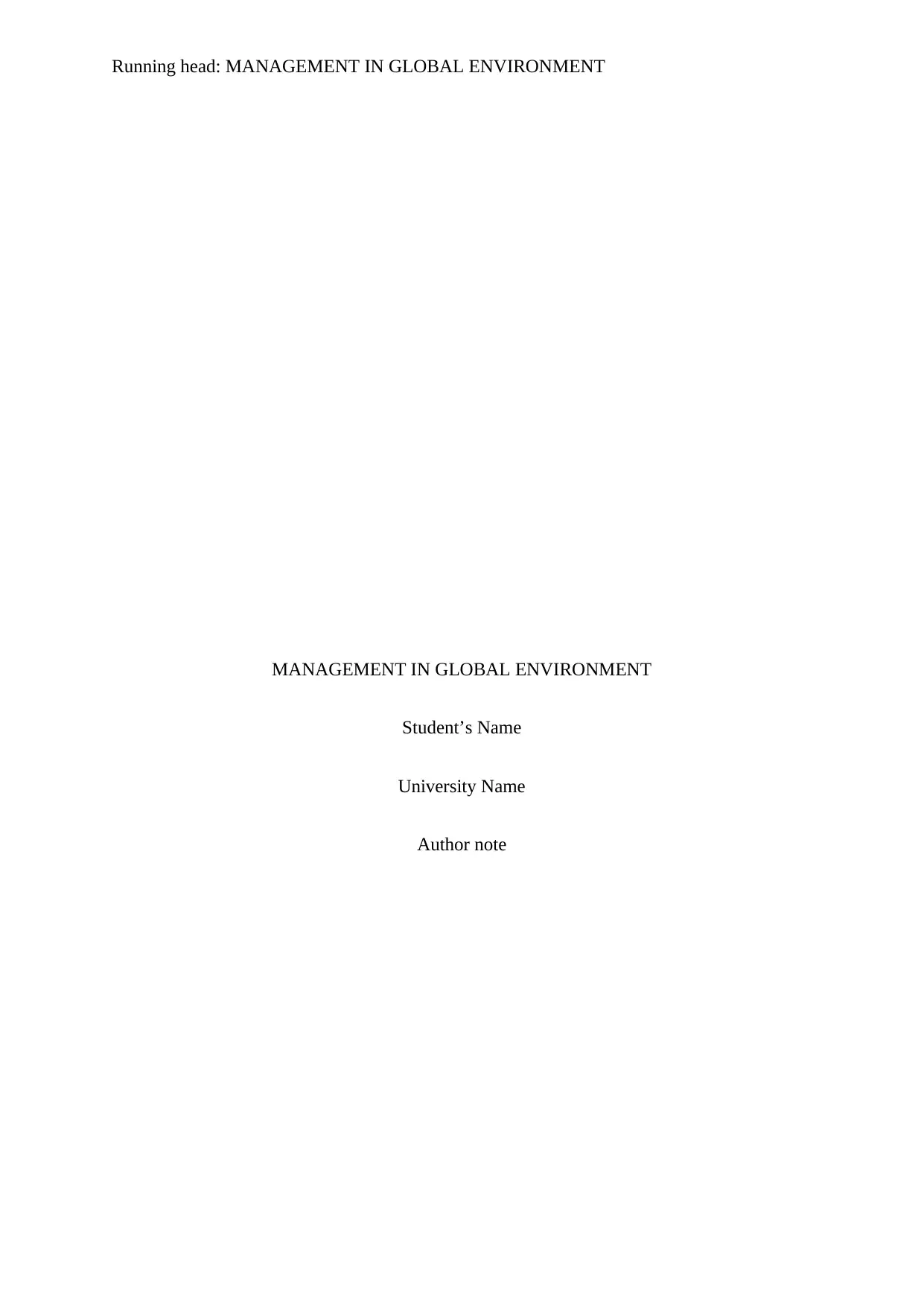
Running head: MANAGEMENT IN GLOBAL ENVIRONMENT
MANAGEMENT IN GLOBAL ENVIRONMENT
Student’s Name
University Name
Author note
MANAGEMENT IN GLOBAL ENVIRONMENT
Student’s Name
University Name
Author note
Secure Best Marks with AI Grader
Need help grading? Try our AI Grader for instant feedback on your assignments.
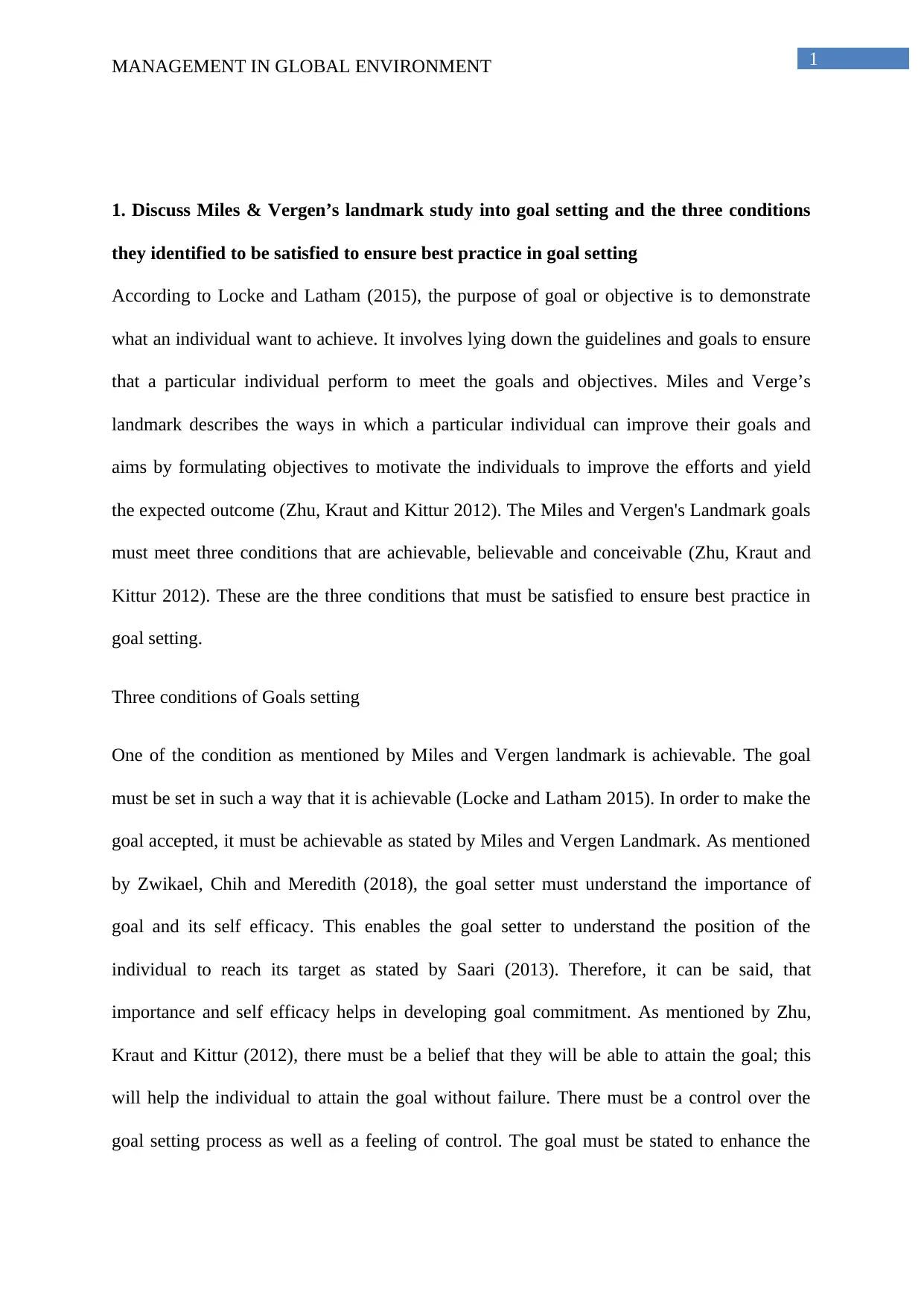
1MANAGEMENT IN GLOBAL ENVIRONMENT
1. Discuss Miles & Vergen’s landmark study into goal setting and the three conditions
they identified to be satisfied to ensure best practice in goal setting
According to Locke and Latham (2015), the purpose of goal or objective is to demonstrate
what an individual want to achieve. It involves lying down the guidelines and goals to ensure
that a particular individual perform to meet the goals and objectives. Miles and Verge’s
landmark describes the ways in which a particular individual can improve their goals and
aims by formulating objectives to motivate the individuals to improve the efforts and yield
the expected outcome (Zhu, Kraut and Kittur 2012). The Miles and Vergen's Landmark goals
must meet three conditions that are achievable, believable and conceivable (Zhu, Kraut and
Kittur 2012). These are the three conditions that must be satisfied to ensure best practice in
goal setting.
Three conditions of Goals setting
One of the condition as mentioned by Miles and Vergen landmark is achievable. The goal
must be set in such a way that it is achievable (Locke and Latham 2015). In order to make the
goal accepted, it must be achievable as stated by Miles and Vergen Landmark. As mentioned
by Zwikael, Chih and Meredith (2018), the goal setter must understand the importance of
goal and its self efficacy. This enables the goal setter to understand the position of the
individual to reach its target as stated by Saari (2013). Therefore, it can be said, that
importance and self efficacy helps in developing goal commitment. As mentioned by Zhu,
Kraut and Kittur (2012), there must be a belief that they will be able to attain the goal; this
will help the individual to attain the goal without failure. There must be a control over the
goal setting process as well as a feeling of control. The goal must be stated to enhance the
1. Discuss Miles & Vergen’s landmark study into goal setting and the three conditions
they identified to be satisfied to ensure best practice in goal setting
According to Locke and Latham (2015), the purpose of goal or objective is to demonstrate
what an individual want to achieve. It involves lying down the guidelines and goals to ensure
that a particular individual perform to meet the goals and objectives. Miles and Verge’s
landmark describes the ways in which a particular individual can improve their goals and
aims by formulating objectives to motivate the individuals to improve the efforts and yield
the expected outcome (Zhu, Kraut and Kittur 2012). The Miles and Vergen's Landmark goals
must meet three conditions that are achievable, believable and conceivable (Zhu, Kraut and
Kittur 2012). These are the three conditions that must be satisfied to ensure best practice in
goal setting.
Three conditions of Goals setting
One of the condition as mentioned by Miles and Vergen landmark is achievable. The goal
must be set in such a way that it is achievable (Locke and Latham 2015). In order to make the
goal accepted, it must be achievable as stated by Miles and Vergen Landmark. As mentioned
by Zwikael, Chih and Meredith (2018), the goal setter must understand the importance of
goal and its self efficacy. This enables the goal setter to understand the position of the
individual to reach its target as stated by Saari (2013). Therefore, it can be said, that
importance and self efficacy helps in developing goal commitment. As mentioned by Zhu,
Kraut and Kittur (2012), there must be a belief that they will be able to attain the goal; this
will help the individual to attain the goal without failure. There must be a control over the
goal setting process as well as a feeling of control. The goal must be stated to enhance the
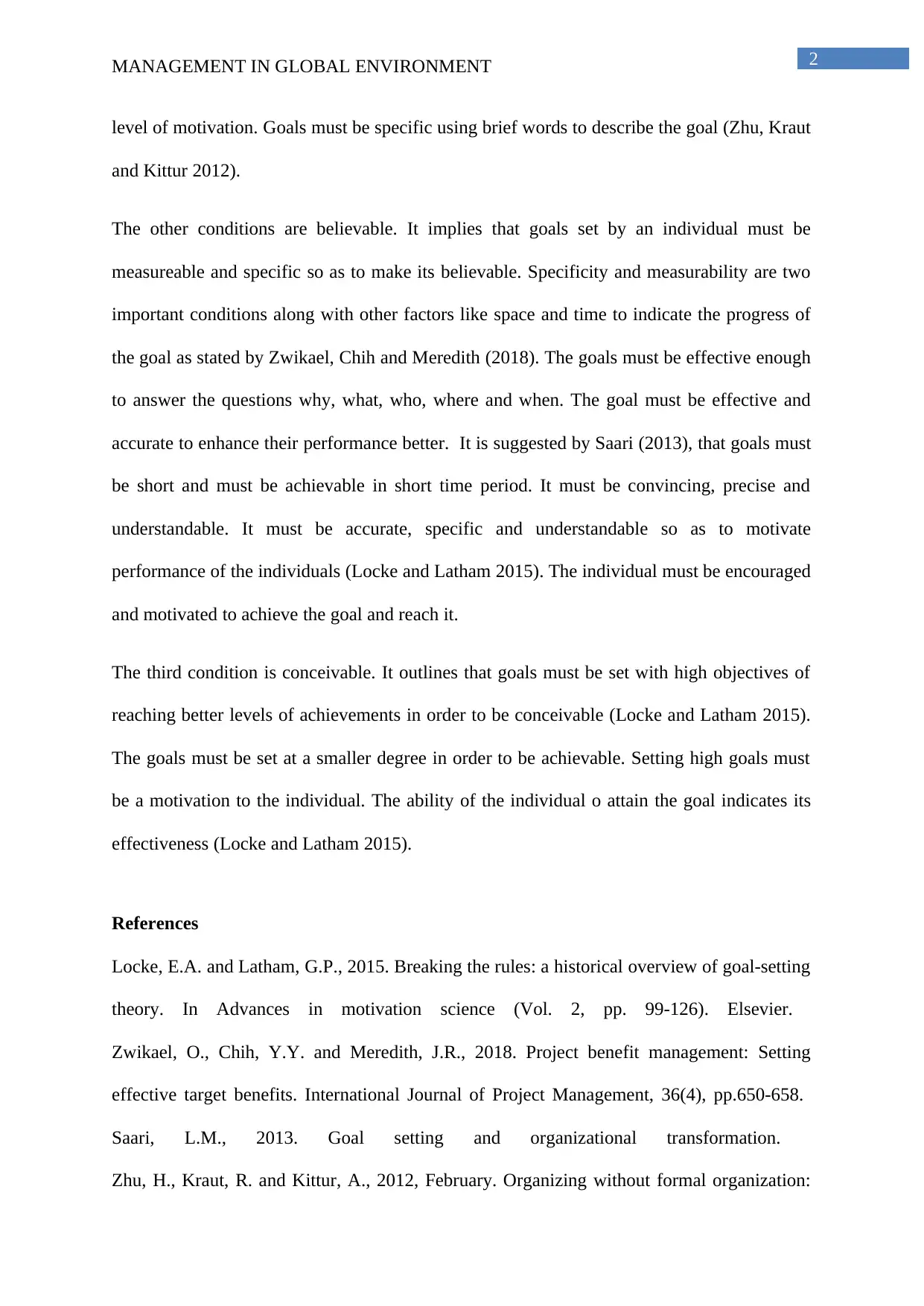
2MANAGEMENT IN GLOBAL ENVIRONMENT
level of motivation. Goals must be specific using brief words to describe the goal (Zhu, Kraut
and Kittur 2012).
The other conditions are believable. It implies that goals set by an individual must be
measureable and specific so as to make its believable. Specificity and measurability are two
important conditions along with other factors like space and time to indicate the progress of
the goal as stated by Zwikael, Chih and Meredith (2018). The goals must be effective enough
to answer the questions why, what, who, where and when. The goal must be effective and
accurate to enhance their performance better. It is suggested by Saari (2013), that goals must
be short and must be achievable in short time period. It must be convincing, precise and
understandable. It must be accurate, specific and understandable so as to motivate
performance of the individuals (Locke and Latham 2015). The individual must be encouraged
and motivated to achieve the goal and reach it.
The third condition is conceivable. It outlines that goals must be set with high objectives of
reaching better levels of achievements in order to be conceivable (Locke and Latham 2015).
The goals must be set at a smaller degree in order to be achievable. Setting high goals must
be a motivation to the individual. The ability of the individual o attain the goal indicates its
effectiveness (Locke and Latham 2015).
References
Locke, E.A. and Latham, G.P., 2015. Breaking the rules: a historical overview of goal-setting
theory. In Advances in motivation science (Vol. 2, pp. 99-126). Elsevier.
Zwikael, O., Chih, Y.Y. and Meredith, J.R., 2018. Project benefit management: Setting
effective target benefits. International Journal of Project Management, 36(4), pp.650-658.
Saari, L.M., 2013. Goal setting and organizational transformation.
Zhu, H., Kraut, R. and Kittur, A., 2012, February. Organizing without formal organization:
level of motivation. Goals must be specific using brief words to describe the goal (Zhu, Kraut
and Kittur 2012).
The other conditions are believable. It implies that goals set by an individual must be
measureable and specific so as to make its believable. Specificity and measurability are two
important conditions along with other factors like space and time to indicate the progress of
the goal as stated by Zwikael, Chih and Meredith (2018). The goals must be effective enough
to answer the questions why, what, who, where and when. The goal must be effective and
accurate to enhance their performance better. It is suggested by Saari (2013), that goals must
be short and must be achievable in short time period. It must be convincing, precise and
understandable. It must be accurate, specific and understandable so as to motivate
performance of the individuals (Locke and Latham 2015). The individual must be encouraged
and motivated to achieve the goal and reach it.
The third condition is conceivable. It outlines that goals must be set with high objectives of
reaching better levels of achievements in order to be conceivable (Locke and Latham 2015).
The goals must be set at a smaller degree in order to be achievable. Setting high goals must
be a motivation to the individual. The ability of the individual o attain the goal indicates its
effectiveness (Locke and Latham 2015).
References
Locke, E.A. and Latham, G.P., 2015. Breaking the rules: a historical overview of goal-setting
theory. In Advances in motivation science (Vol. 2, pp. 99-126). Elsevier.
Zwikael, O., Chih, Y.Y. and Meredith, J.R., 2018. Project benefit management: Setting
effective target benefits. International Journal of Project Management, 36(4), pp.650-658.
Saari, L.M., 2013. Goal setting and organizational transformation.
Zhu, H., Kraut, R. and Kittur, A., 2012, February. Organizing without formal organization:
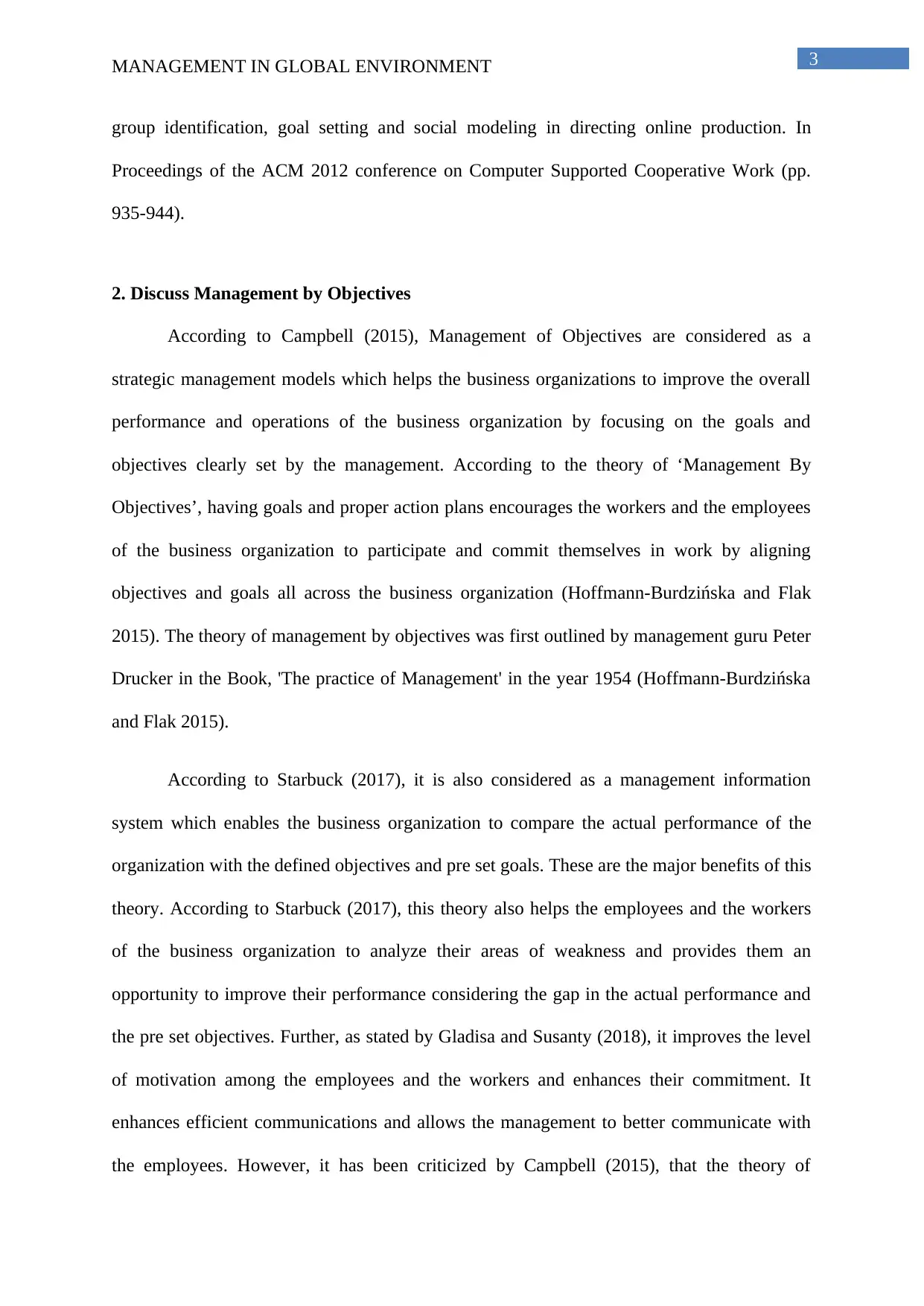
3MANAGEMENT IN GLOBAL ENVIRONMENT
group identification, goal setting and social modeling in directing online production. In
Proceedings of the ACM 2012 conference on Computer Supported Cooperative Work (pp.
935-944).
2. Discuss Management by Objectives
According to Campbell (2015), Management of Objectives are considered as a
strategic management models which helps the business organizations to improve the overall
performance and operations of the business organization by focusing on the goals and
objectives clearly set by the management. According to the theory of ‘Management By
Objectives’, having goals and proper action plans encourages the workers and the employees
of the business organization to participate and commit themselves in work by aligning
objectives and goals all across the business organization (Hoffmann-Burdzińska and Flak
2015). The theory of management by objectives was first outlined by management guru Peter
Drucker in the Book, 'The practice of Management' in the year 1954 (Hoffmann-Burdzińska
and Flak 2015).
According to Starbuck (2017), it is also considered as a management information
system which enables the business organization to compare the actual performance of the
organization with the defined objectives and pre set goals. These are the major benefits of this
theory. According to Starbuck (2017), this theory also helps the employees and the workers
of the business organization to analyze their areas of weakness and provides them an
opportunity to improve their performance considering the gap in the actual performance and
the pre set objectives. Further, as stated by Gladisa and Susanty (2018), it improves the level
of motivation among the employees and the workers and enhances their commitment. It
enhances efficient communications and allows the management to better communicate with
the employees. However, it has been criticized by Campbell (2015), that the theory of
group identification, goal setting and social modeling in directing online production. In
Proceedings of the ACM 2012 conference on Computer Supported Cooperative Work (pp.
935-944).
2. Discuss Management by Objectives
According to Campbell (2015), Management of Objectives are considered as a
strategic management models which helps the business organizations to improve the overall
performance and operations of the business organization by focusing on the goals and
objectives clearly set by the management. According to the theory of ‘Management By
Objectives’, having goals and proper action plans encourages the workers and the employees
of the business organization to participate and commit themselves in work by aligning
objectives and goals all across the business organization (Hoffmann-Burdzińska and Flak
2015). The theory of management by objectives was first outlined by management guru Peter
Drucker in the Book, 'The practice of Management' in the year 1954 (Hoffmann-Burdzińska
and Flak 2015).
According to Starbuck (2017), it is also considered as a management information
system which enables the business organization to compare the actual performance of the
organization with the defined objectives and pre set goals. These are the major benefits of this
theory. According to Starbuck (2017), this theory also helps the employees and the workers
of the business organization to analyze their areas of weakness and provides them an
opportunity to improve their performance considering the gap in the actual performance and
the pre set objectives. Further, as stated by Gladisa and Susanty (2018), it improves the level
of motivation among the employees and the workers and enhances their commitment. It
enhances efficient communications and allows the management to better communicate with
the employees. However, it has been criticized by Campbell (2015), that the theory of
Secure Best Marks with AI Grader
Need help grading? Try our AI Grader for instant feedback on your assignments.
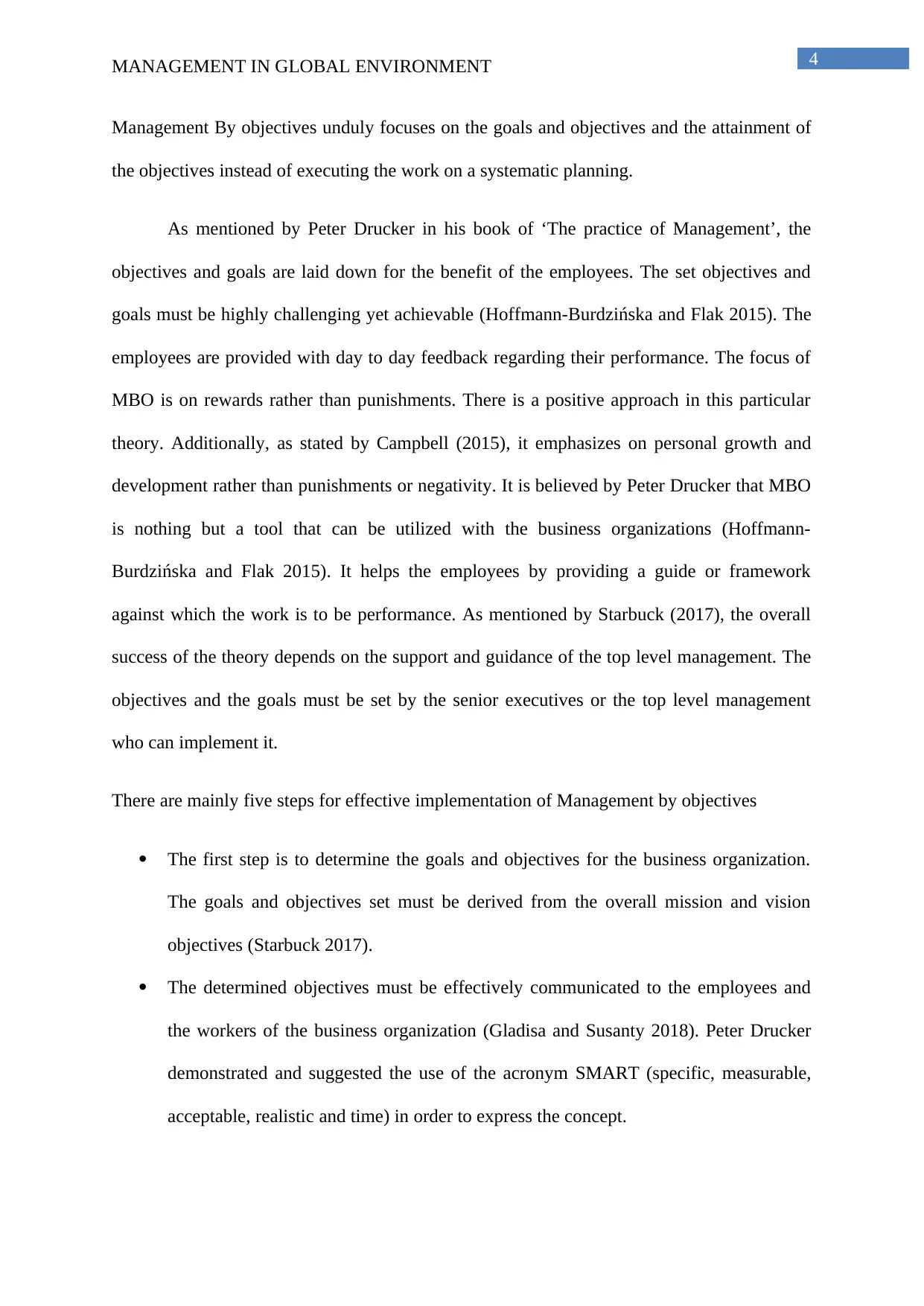
4MANAGEMENT IN GLOBAL ENVIRONMENT
Management By objectives unduly focuses on the goals and objectives and the attainment of
the objectives instead of executing the work on a systematic planning.
As mentioned by Peter Drucker in his book of ‘The practice of Management’, the
objectives and goals are laid down for the benefit of the employees. The set objectives and
goals must be highly challenging yet achievable (Hoffmann-Burdzińska and Flak 2015). The
employees are provided with day to day feedback regarding their performance. The focus of
MBO is on rewards rather than punishments. There is a positive approach in this particular
theory. Additionally, as stated by Campbell (2015), it emphasizes on personal growth and
development rather than punishments or negativity. It is believed by Peter Drucker that MBO
is nothing but a tool that can be utilized with the business organizations (Hoffmann-
Burdzińska and Flak 2015). It helps the employees by providing a guide or framework
against which the work is to be performance. As mentioned by Starbuck (2017), the overall
success of the theory depends on the support and guidance of the top level management. The
objectives and the goals must be set by the senior executives or the top level management
who can implement it.
There are mainly five steps for effective implementation of Management by objectives
The first step is to determine the goals and objectives for the business organization.
The goals and objectives set must be derived from the overall mission and vision
objectives (Starbuck 2017).
The determined objectives must be effectively communicated to the employees and
the workers of the business organization (Gladisa and Susanty 2018). Peter Drucker
demonstrated and suggested the use of the acronym SMART (specific, measurable,
acceptable, realistic and time) in order to express the concept.
Management By objectives unduly focuses on the goals and objectives and the attainment of
the objectives instead of executing the work on a systematic planning.
As mentioned by Peter Drucker in his book of ‘The practice of Management’, the
objectives and goals are laid down for the benefit of the employees. The set objectives and
goals must be highly challenging yet achievable (Hoffmann-Burdzińska and Flak 2015). The
employees are provided with day to day feedback regarding their performance. The focus of
MBO is on rewards rather than punishments. There is a positive approach in this particular
theory. Additionally, as stated by Campbell (2015), it emphasizes on personal growth and
development rather than punishments or negativity. It is believed by Peter Drucker that MBO
is nothing but a tool that can be utilized with the business organizations (Hoffmann-
Burdzińska and Flak 2015). It helps the employees by providing a guide or framework
against which the work is to be performance. As mentioned by Starbuck (2017), the overall
success of the theory depends on the support and guidance of the top level management. The
objectives and the goals must be set by the senior executives or the top level management
who can implement it.
There are mainly five steps for effective implementation of Management by objectives
The first step is to determine the goals and objectives for the business organization.
The goals and objectives set must be derived from the overall mission and vision
objectives (Starbuck 2017).
The determined objectives must be effectively communicated to the employees and
the workers of the business organization (Gladisa and Susanty 2018). Peter Drucker
demonstrated and suggested the use of the acronym SMART (specific, measurable,
acceptable, realistic and time) in order to express the concept.
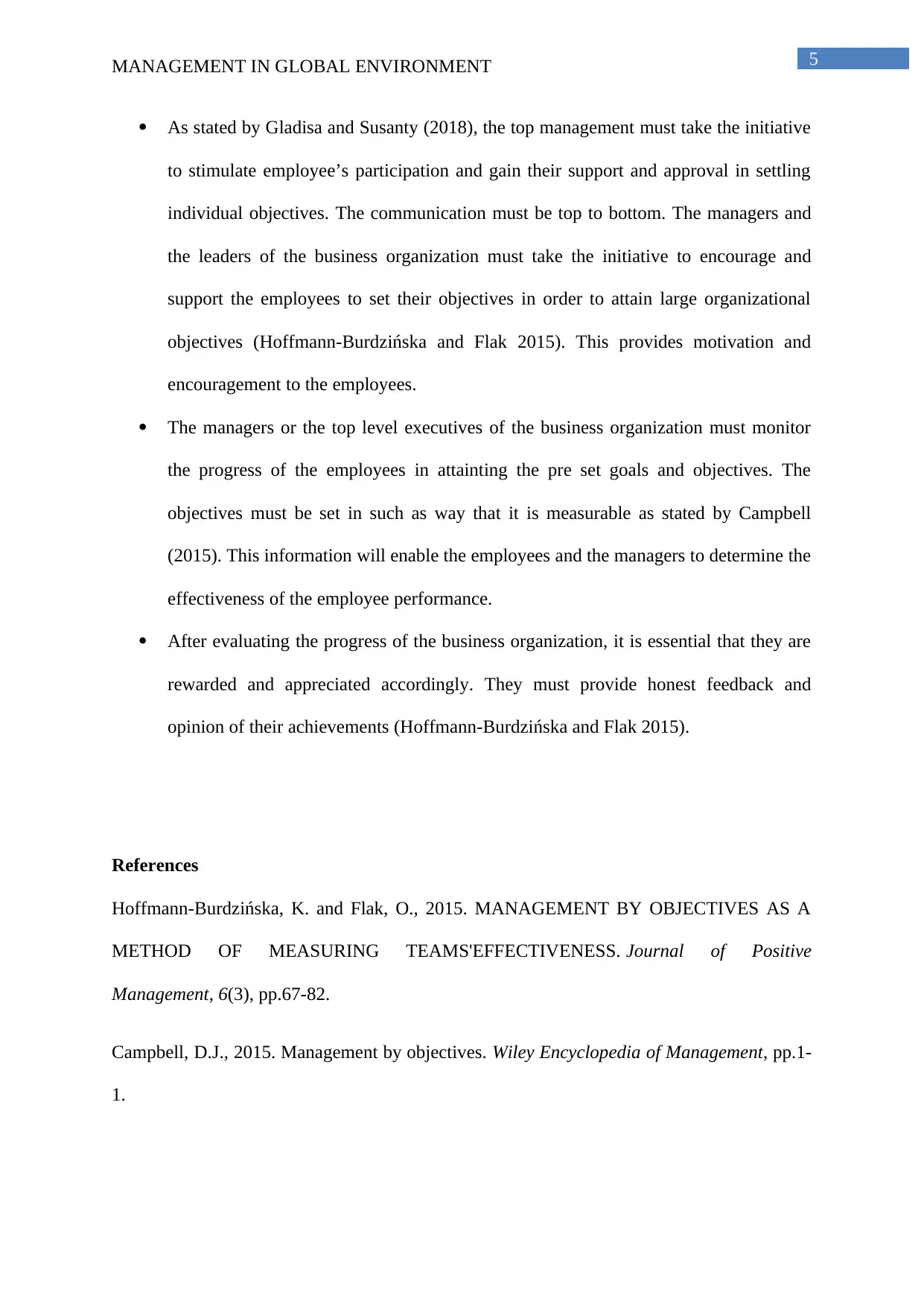
5MANAGEMENT IN GLOBAL ENVIRONMENT
As stated by Gladisa and Susanty (2018), the top management must take the initiative
to stimulate employee’s participation and gain their support and approval in settling
individual objectives. The communication must be top to bottom. The managers and
the leaders of the business organization must take the initiative to encourage and
support the employees to set their objectives in order to attain large organizational
objectives (Hoffmann-Burdzińska and Flak 2015). This provides motivation and
encouragement to the employees.
The managers or the top level executives of the business organization must monitor
the progress of the employees in attainting the pre set goals and objectives. The
objectives must be set in such as way that it is measurable as stated by Campbell
(2015). This information will enable the employees and the managers to determine the
effectiveness of the employee performance.
After evaluating the progress of the business organization, it is essential that they are
rewarded and appreciated accordingly. They must provide honest feedback and
opinion of their achievements (Hoffmann-Burdzińska and Flak 2015).
References
Hoffmann-Burdzińska, K. and Flak, O., 2015. MANAGEMENT BY OBJECTIVES AS A
METHOD OF MEASURING TEAMS'EFFECTIVENESS. Journal of Positive
Management, 6(3), pp.67-82.
Campbell, D.J., 2015. Management by objectives. Wiley Encyclopedia of Management, pp.1-
1.
As stated by Gladisa and Susanty (2018), the top management must take the initiative
to stimulate employee’s participation and gain their support and approval in settling
individual objectives. The communication must be top to bottom. The managers and
the leaders of the business organization must take the initiative to encourage and
support the employees to set their objectives in order to attain large organizational
objectives (Hoffmann-Burdzińska and Flak 2015). This provides motivation and
encouragement to the employees.
The managers or the top level executives of the business organization must monitor
the progress of the employees in attainting the pre set goals and objectives. The
objectives must be set in such as way that it is measurable as stated by Campbell
(2015). This information will enable the employees and the managers to determine the
effectiveness of the employee performance.
After evaluating the progress of the business organization, it is essential that they are
rewarded and appreciated accordingly. They must provide honest feedback and
opinion of their achievements (Hoffmann-Burdzińska and Flak 2015).
References
Hoffmann-Burdzińska, K. and Flak, O., 2015. MANAGEMENT BY OBJECTIVES AS A
METHOD OF MEASURING TEAMS'EFFECTIVENESS. Journal of Positive
Management, 6(3), pp.67-82.
Campbell, D.J., 2015. Management by objectives. Wiley Encyclopedia of Management, pp.1-
1.
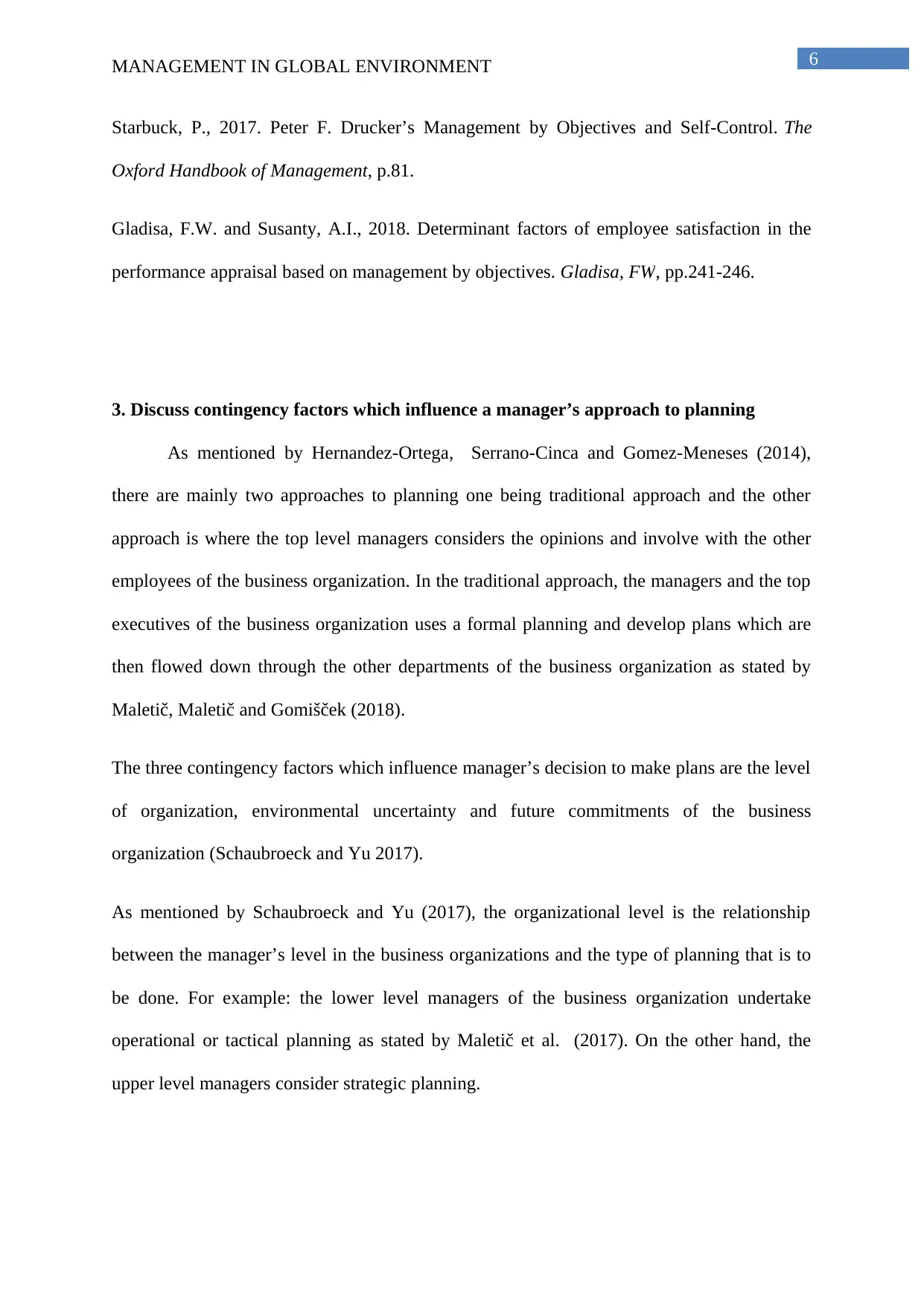
6MANAGEMENT IN GLOBAL ENVIRONMENT
Starbuck, P., 2017. Peter F. Drucker’s Management by Objectives and Self-Control. The
Oxford Handbook of Management, p.81.
Gladisa, F.W. and Susanty, A.I., 2018. Determinant factors of employee satisfaction in the
performance appraisal based on management by objectives. Gladisa, FW, pp.241-246.
3. Discuss contingency factors which influence a manager’s approach to planning
As mentioned by Hernandez-Ortega, Serrano-Cinca and Gomez-Meneses (2014),
there are mainly two approaches to planning one being traditional approach and the other
approach is where the top level managers considers the opinions and involve with the other
employees of the business organization. In the traditional approach, the managers and the top
executives of the business organization uses a formal planning and develop plans which are
then flowed down through the other departments of the business organization as stated by
Maletič, Maletič and Gomišček (2018).
The three contingency factors which influence manager’s decision to make plans are the level
of organization, environmental uncertainty and future commitments of the business
organization (Schaubroeck and Yu 2017).
As mentioned by Schaubroeck and Yu (2017), the organizational level is the relationship
between the manager’s level in the business organizations and the type of planning that is to
be done. For example: the lower level managers of the business organization undertake
operational or tactical planning as stated by Maletič et al. (2017). On the other hand, the
upper level managers consider strategic planning.
Starbuck, P., 2017. Peter F. Drucker’s Management by Objectives and Self-Control. The
Oxford Handbook of Management, p.81.
Gladisa, F.W. and Susanty, A.I., 2018. Determinant factors of employee satisfaction in the
performance appraisal based on management by objectives. Gladisa, FW, pp.241-246.
3. Discuss contingency factors which influence a manager’s approach to planning
As mentioned by Hernandez-Ortega, Serrano-Cinca and Gomez-Meneses (2014),
there are mainly two approaches to planning one being traditional approach and the other
approach is where the top level managers considers the opinions and involve with the other
employees of the business organization. In the traditional approach, the managers and the top
executives of the business organization uses a formal planning and develop plans which are
then flowed down through the other departments of the business organization as stated by
Maletič, Maletič and Gomišček (2018).
The three contingency factors which influence manager’s decision to make plans are the level
of organization, environmental uncertainty and future commitments of the business
organization (Schaubroeck and Yu 2017).
As mentioned by Schaubroeck and Yu (2017), the organizational level is the relationship
between the manager’s level in the business organizations and the type of planning that is to
be done. For example: the lower level managers of the business organization undertake
operational or tactical planning as stated by Maletič et al. (2017). On the other hand, the
upper level managers consider strategic planning.
Paraphrase This Document
Need a fresh take? Get an instant paraphrase of this document with our AI Paraphraser
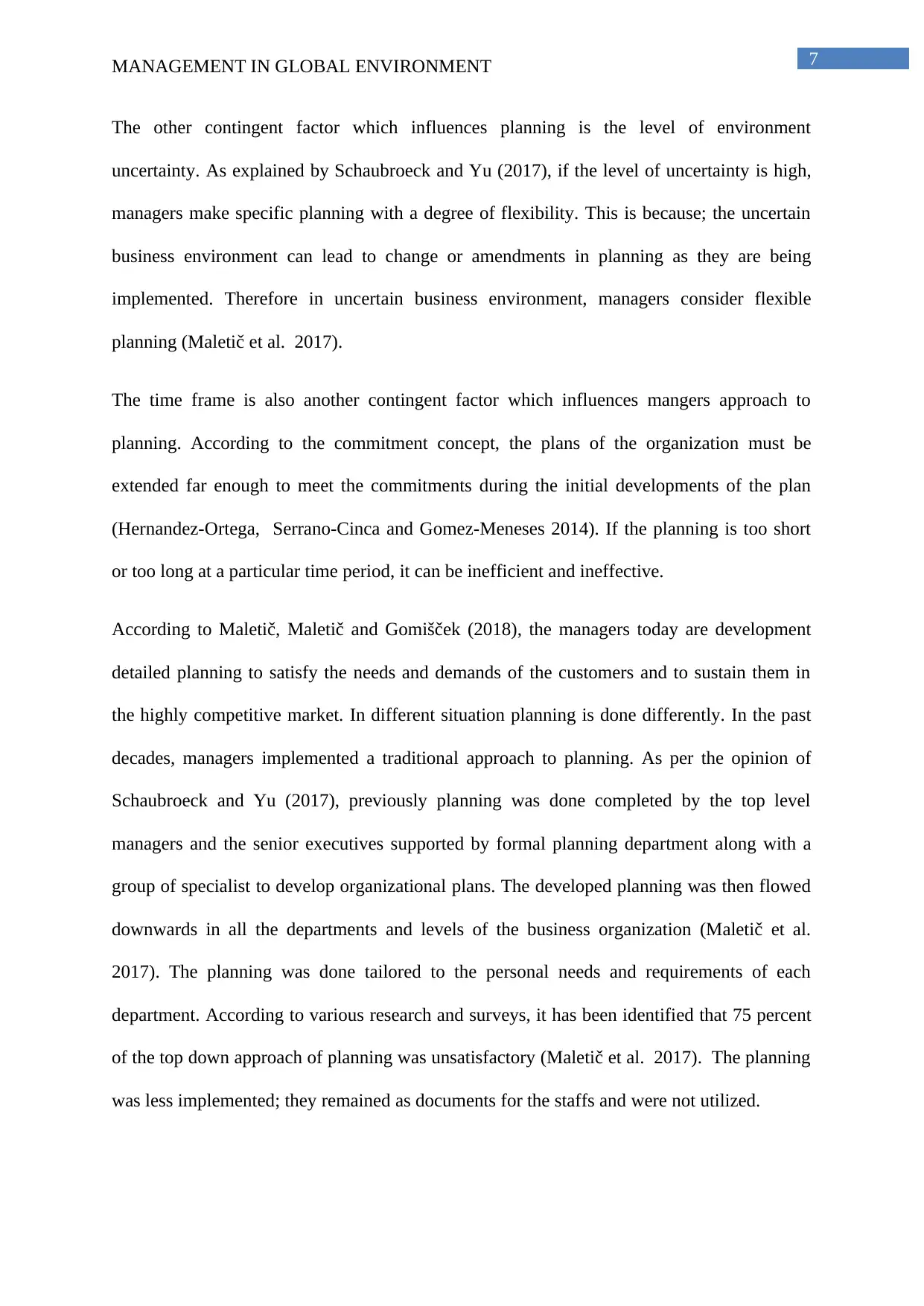
7MANAGEMENT IN GLOBAL ENVIRONMENT
The other contingent factor which influences planning is the level of environment
uncertainty. As explained by Schaubroeck and Yu (2017), if the level of uncertainty is high,
managers make specific planning with a degree of flexibility. This is because; the uncertain
business environment can lead to change or amendments in planning as they are being
implemented. Therefore in uncertain business environment, managers consider flexible
planning (Maletič et al. 2017).
The time frame is also another contingent factor which influences mangers approach to
planning. According to the commitment concept, the plans of the organization must be
extended far enough to meet the commitments during the initial developments of the plan
(Hernandez-Ortega, Serrano-Cinca and Gomez-Meneses 2014). If the planning is too short
or too long at a particular time period, it can be inefficient and ineffective.
According to Maletič, Maletič and Gomišček (2018), the managers today are development
detailed planning to satisfy the needs and demands of the customers and to sustain them in
the highly competitive market. In different situation planning is done differently. In the past
decades, managers implemented a traditional approach to planning. As per the opinion of
Schaubroeck and Yu (2017), previously planning was done completed by the top level
managers and the senior executives supported by formal planning department along with a
group of specialist to develop organizational plans. The developed planning was then flowed
downwards in all the departments and levels of the business organization (Maletič et al.
2017). The planning was done tailored to the personal needs and requirements of each
department. According to various research and surveys, it has been identified that 75 percent
of the top down approach of planning was unsatisfactory (Maletič et al. 2017). The planning
was less implemented; they remained as documents for the staffs and were not utilized.
The other contingent factor which influences planning is the level of environment
uncertainty. As explained by Schaubroeck and Yu (2017), if the level of uncertainty is high,
managers make specific planning with a degree of flexibility. This is because; the uncertain
business environment can lead to change or amendments in planning as they are being
implemented. Therefore in uncertain business environment, managers consider flexible
planning (Maletič et al. 2017).
The time frame is also another contingent factor which influences mangers approach to
planning. According to the commitment concept, the plans of the organization must be
extended far enough to meet the commitments during the initial developments of the plan
(Hernandez-Ortega, Serrano-Cinca and Gomez-Meneses 2014). If the planning is too short
or too long at a particular time period, it can be inefficient and ineffective.
According to Maletič, Maletič and Gomišček (2018), the managers today are development
detailed planning to satisfy the needs and demands of the customers and to sustain them in
the highly competitive market. In different situation planning is done differently. In the past
decades, managers implemented a traditional approach to planning. As per the opinion of
Schaubroeck and Yu (2017), previously planning was done completed by the top level
managers and the senior executives supported by formal planning department along with a
group of specialist to develop organizational plans. The developed planning was then flowed
downwards in all the departments and levels of the business organization (Maletič et al.
2017). The planning was done tailored to the personal needs and requirements of each
department. According to various research and surveys, it has been identified that 75 percent
of the top down approach of planning was unsatisfactory (Maletič et al. 2017). The planning
was less implemented; they remained as documents for the staffs and were not utilized.
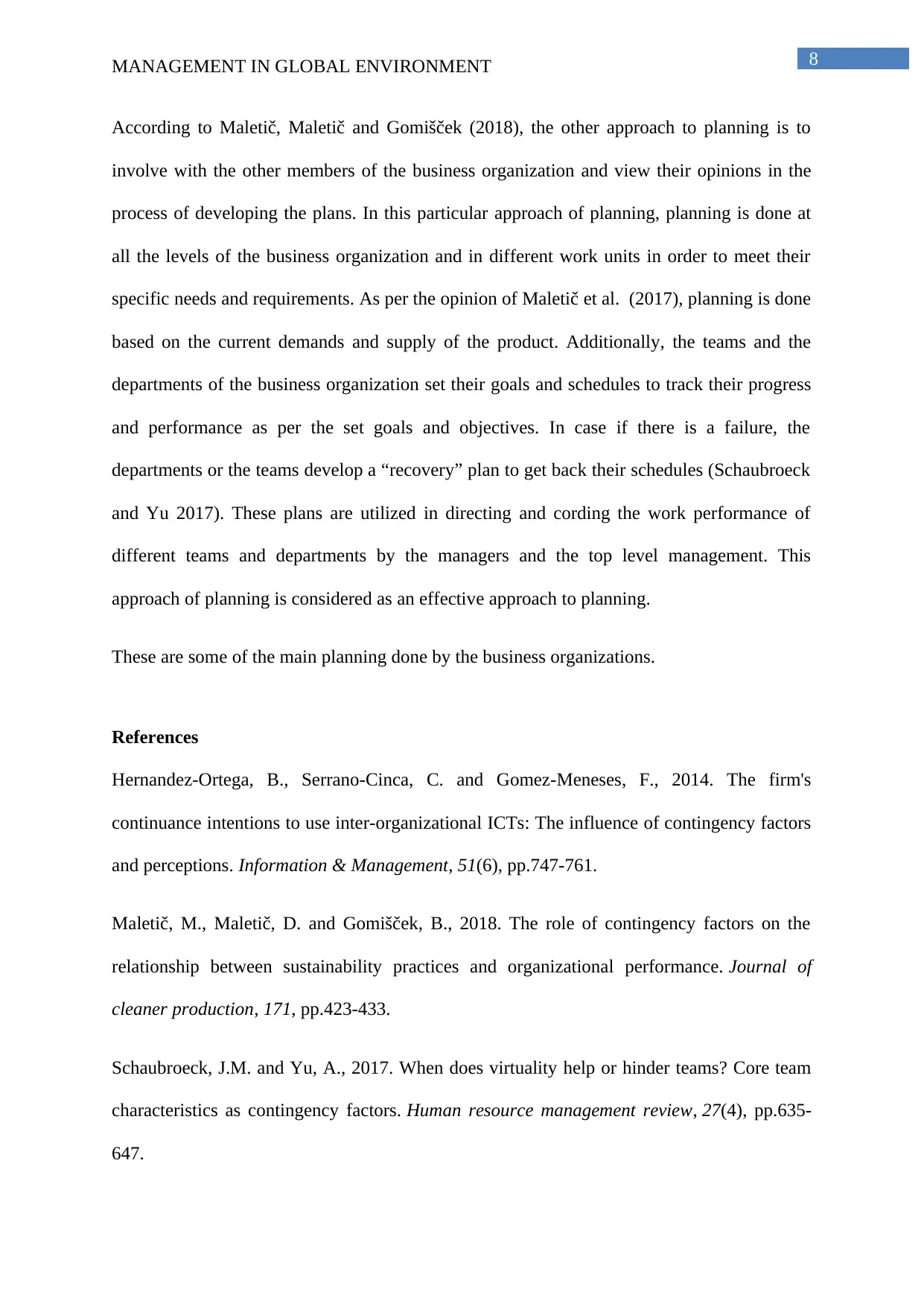
8MANAGEMENT IN GLOBAL ENVIRONMENT
According to Maletič, Maletič and Gomišček (2018), the other approach to planning is to
involve with the other members of the business organization and view their opinions in the
process of developing the plans. In this particular approach of planning, planning is done at
all the levels of the business organization and in different work units in order to meet their
specific needs and requirements. As per the opinion of Maletič et al. (2017), planning is done
based on the current demands and supply of the product. Additionally, the teams and the
departments of the business organization set their goals and schedules to track their progress
and performance as per the set goals and objectives. In case if there is a failure, the
departments or the teams develop a “recovery” plan to get back their schedules (Schaubroeck
and Yu 2017). These plans are utilized in directing and cording the work performance of
different teams and departments by the managers and the top level management. This
approach of planning is considered as an effective approach to planning.
These are some of the main planning done by the business organizations.
References
Hernandez-Ortega, B., Serrano-Cinca, C. and Gomez-Meneses, F., 2014. The firm's
continuance intentions to use inter-organizational ICTs: The influence of contingency factors
and perceptions. Information & Management, 51(6), pp.747-761.
Maletič, M., Maletič, D. and Gomišček, B., 2018. The role of contingency factors on the
relationship between sustainability practices and organizational performance. Journal of
cleaner production, 171, pp.423-433.
Schaubroeck, J.M. and Yu, A., 2017. When does virtuality help or hinder teams? Core team
characteristics as contingency factors. Human resource management review, 27(4), pp.635-
647.
According to Maletič, Maletič and Gomišček (2018), the other approach to planning is to
involve with the other members of the business organization and view their opinions in the
process of developing the plans. In this particular approach of planning, planning is done at
all the levels of the business organization and in different work units in order to meet their
specific needs and requirements. As per the opinion of Maletič et al. (2017), planning is done
based on the current demands and supply of the product. Additionally, the teams and the
departments of the business organization set their goals and schedules to track their progress
and performance as per the set goals and objectives. In case if there is a failure, the
departments or the teams develop a “recovery” plan to get back their schedules (Schaubroeck
and Yu 2017). These plans are utilized in directing and cording the work performance of
different teams and departments by the managers and the top level management. This
approach of planning is considered as an effective approach to planning.
These are some of the main planning done by the business organizations.
References
Hernandez-Ortega, B., Serrano-Cinca, C. and Gomez-Meneses, F., 2014. The firm's
continuance intentions to use inter-organizational ICTs: The influence of contingency factors
and perceptions. Information & Management, 51(6), pp.747-761.
Maletič, M., Maletič, D. and Gomišček, B., 2018. The role of contingency factors on the
relationship between sustainability practices and organizational performance. Journal of
cleaner production, 171, pp.423-433.
Schaubroeck, J.M. and Yu, A., 2017. When does virtuality help or hinder teams? Core team
characteristics as contingency factors. Human resource management review, 27(4), pp.635-
647.
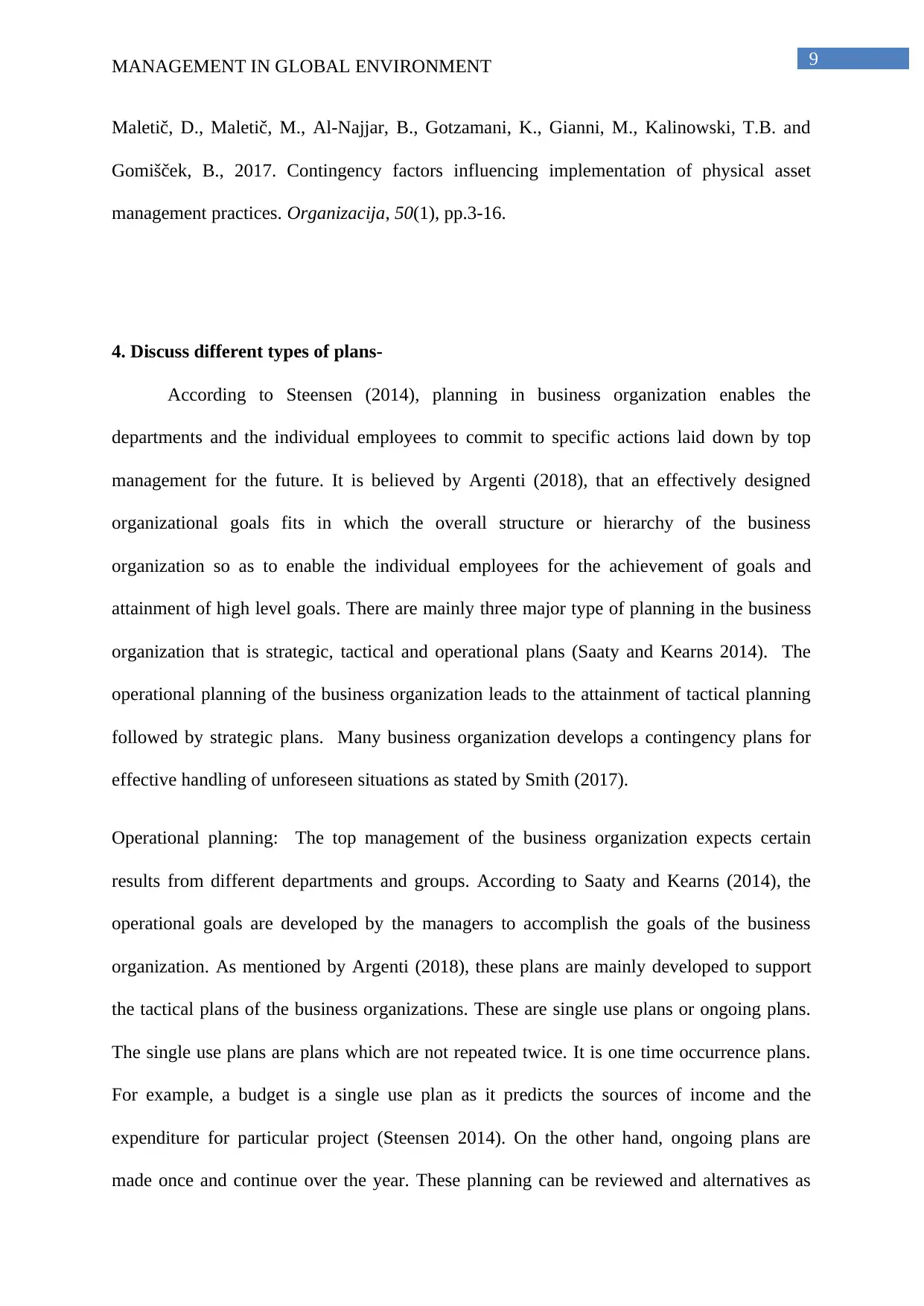
9MANAGEMENT IN GLOBAL ENVIRONMENT
Maletič, D., Maletič, M., Al-Najjar, B., Gotzamani, K., Gianni, M., Kalinowski, T.B. and
Gomišček, B., 2017. Contingency factors influencing implementation of physical asset
management practices. Organizacija, 50(1), pp.3-16.
4. Discuss different types of plans-
According to Steensen (2014), planning in business organization enables the
departments and the individual employees to commit to specific actions laid down by top
management for the future. It is believed by Argenti (2018), that an effectively designed
organizational goals fits in which the overall structure or hierarchy of the business
organization so as to enable the individual employees for the achievement of goals and
attainment of high level goals. There are mainly three major type of planning in the business
organization that is strategic, tactical and operational plans (Saaty and Kearns 2014). The
operational planning of the business organization leads to the attainment of tactical planning
followed by strategic plans. Many business organization develops a contingency plans for
effective handling of unforeseen situations as stated by Smith (2017).
Operational planning: The top management of the business organization expects certain
results from different departments and groups. According to Saaty and Kearns (2014), the
operational goals are developed by the managers to accomplish the goals of the business
organization. As mentioned by Argenti (2018), these plans are mainly developed to support
the tactical plans of the business organizations. These are single use plans or ongoing plans.
The single use plans are plans which are not repeated twice. It is one time occurrence plans.
For example, a budget is a single use plan as it predicts the sources of income and the
expenditure for particular project (Steensen 2014). On the other hand, ongoing plans are
made once and continue over the year. These planning can be reviewed and alternatives as
Maletič, D., Maletič, M., Al-Najjar, B., Gotzamani, K., Gianni, M., Kalinowski, T.B. and
Gomišček, B., 2017. Contingency factors influencing implementation of physical asset
management practices. Organizacija, 50(1), pp.3-16.
4. Discuss different types of plans-
According to Steensen (2014), planning in business organization enables the
departments and the individual employees to commit to specific actions laid down by top
management for the future. It is believed by Argenti (2018), that an effectively designed
organizational goals fits in which the overall structure or hierarchy of the business
organization so as to enable the individual employees for the achievement of goals and
attainment of high level goals. There are mainly three major type of planning in the business
organization that is strategic, tactical and operational plans (Saaty and Kearns 2014). The
operational planning of the business organization leads to the attainment of tactical planning
followed by strategic plans. Many business organization develops a contingency plans for
effective handling of unforeseen situations as stated by Smith (2017).
Operational planning: The top management of the business organization expects certain
results from different departments and groups. According to Saaty and Kearns (2014), the
operational goals are developed by the managers to accomplish the goals of the business
organization. As mentioned by Argenti (2018), these plans are mainly developed to support
the tactical plans of the business organizations. These are single use plans or ongoing plans.
The single use plans are plans which are not repeated twice. It is one time occurrence plans.
For example, a budget is a single use plan as it predicts the sources of income and the
expenditure for particular project (Steensen 2014). On the other hand, ongoing plans are
made once and continue over the year. These planning can be reviewed and alternatives as
Secure Best Marks with AI Grader
Need help grading? Try our AI Grader for instant feedback on your assignments.
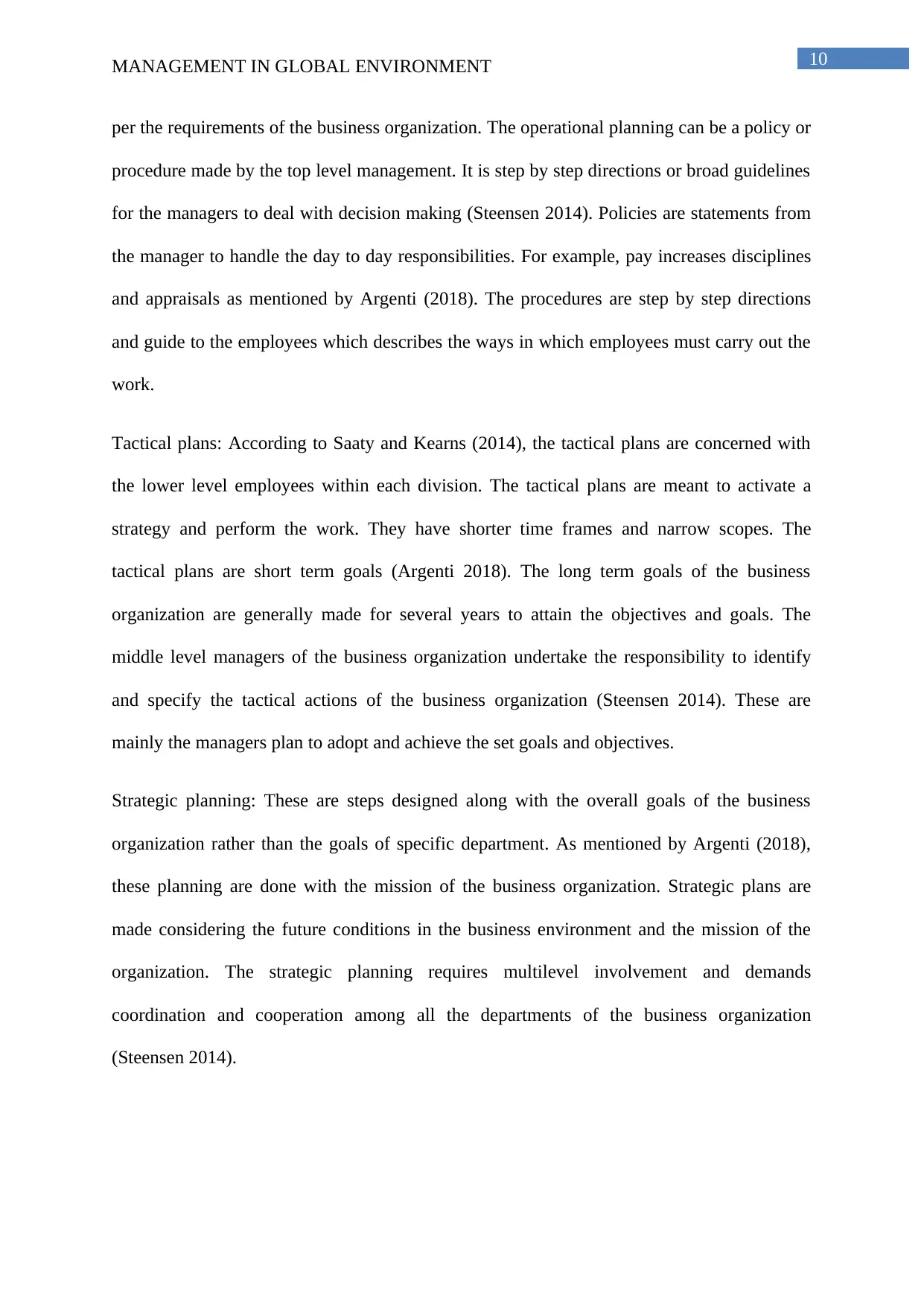
10MANAGEMENT IN GLOBAL ENVIRONMENT
per the requirements of the business organization. The operational planning can be a policy or
procedure made by the top level management. It is step by step directions or broad guidelines
for the managers to deal with decision making (Steensen 2014). Policies are statements from
the manager to handle the day to day responsibilities. For example, pay increases disciplines
and appraisals as mentioned by Argenti (2018). The procedures are step by step directions
and guide to the employees which describes the ways in which employees must carry out the
work.
Tactical plans: According to Saaty and Kearns (2014), the tactical plans are concerned with
the lower level employees within each division. The tactical plans are meant to activate a
strategy and perform the work. They have shorter time frames and narrow scopes. The
tactical plans are short term goals (Argenti 2018). The long term goals of the business
organization are generally made for several years to attain the objectives and goals. The
middle level managers of the business organization undertake the responsibility to identify
and specify the tactical actions of the business organization (Steensen 2014). These are
mainly the managers plan to adopt and achieve the set goals and objectives.
Strategic planning: These are steps designed along with the overall goals of the business
organization rather than the goals of specific department. As mentioned by Argenti (2018),
these planning are done with the mission of the business organization. Strategic plans are
made considering the future conditions in the business environment and the mission of the
organization. The strategic planning requires multilevel involvement and demands
coordination and cooperation among all the departments of the business organization
(Steensen 2014).
per the requirements of the business organization. The operational planning can be a policy or
procedure made by the top level management. It is step by step directions or broad guidelines
for the managers to deal with decision making (Steensen 2014). Policies are statements from
the manager to handle the day to day responsibilities. For example, pay increases disciplines
and appraisals as mentioned by Argenti (2018). The procedures are step by step directions
and guide to the employees which describes the ways in which employees must carry out the
work.
Tactical plans: According to Saaty and Kearns (2014), the tactical plans are concerned with
the lower level employees within each division. The tactical plans are meant to activate a
strategy and perform the work. They have shorter time frames and narrow scopes. The
tactical plans are short term goals (Argenti 2018). The long term goals of the business
organization are generally made for several years to attain the objectives and goals. The
middle level managers of the business organization undertake the responsibility to identify
and specify the tactical actions of the business organization (Steensen 2014). These are
mainly the managers plan to adopt and achieve the set goals and objectives.
Strategic planning: These are steps designed along with the overall goals of the business
organization rather than the goals of specific department. As mentioned by Argenti (2018),
these planning are done with the mission of the business organization. Strategic plans are
made considering the future conditions in the business environment and the mission of the
organization. The strategic planning requires multilevel involvement and demands
coordination and cooperation among all the departments of the business organization
(Steensen 2014).
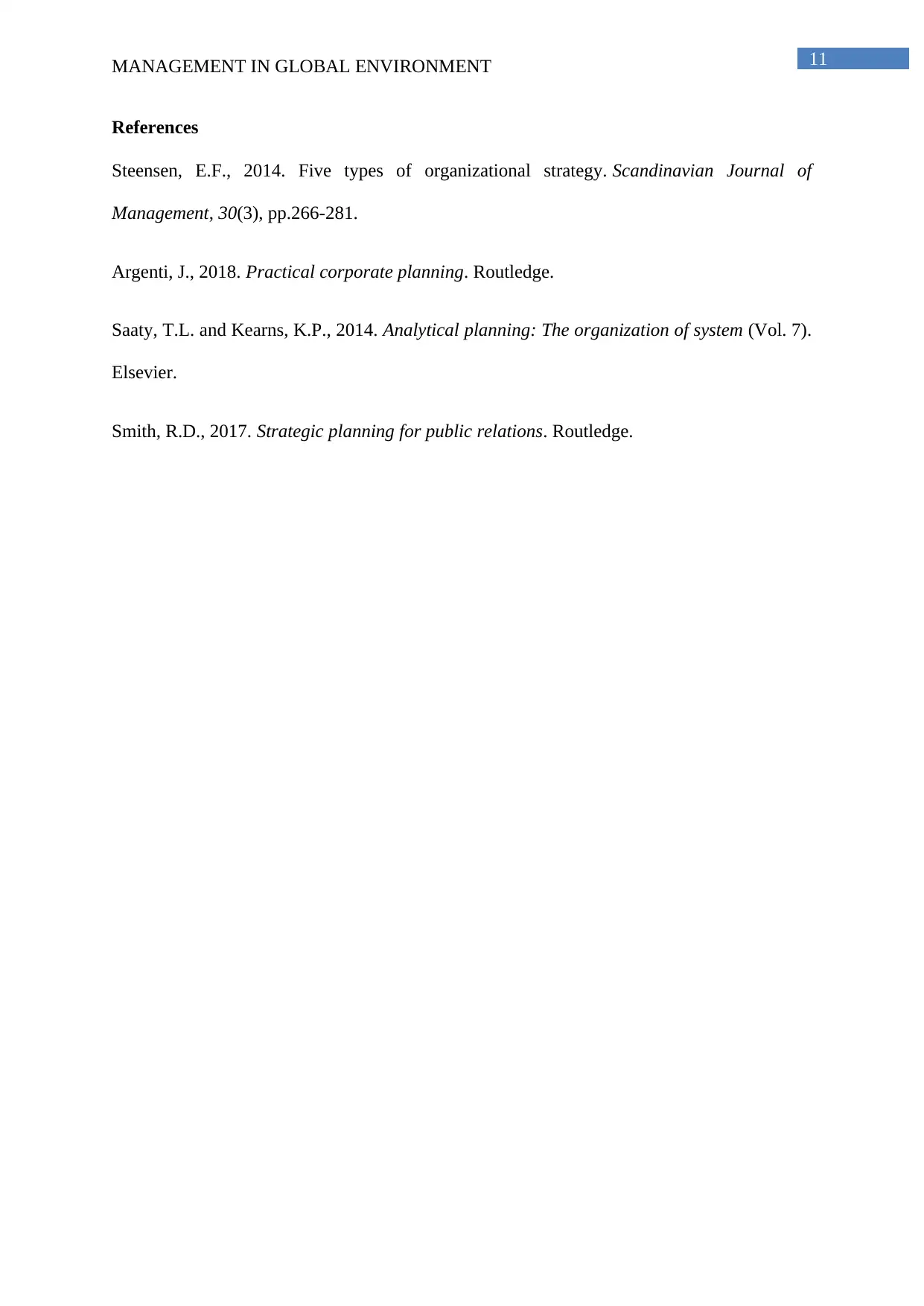
11MANAGEMENT IN GLOBAL ENVIRONMENT
References
Steensen, E.F., 2014. Five types of organizational strategy. Scandinavian Journal of
Management, 30(3), pp.266-281.
Argenti, J., 2018. Practical corporate planning. Routledge.
Saaty, T.L. and Kearns, K.P., 2014. Analytical planning: The organization of system (Vol. 7).
Elsevier.
Smith, R.D., 2017. Strategic planning for public relations. Routledge.
References
Steensen, E.F., 2014. Five types of organizational strategy. Scandinavian Journal of
Management, 30(3), pp.266-281.
Argenti, J., 2018. Practical corporate planning. Routledge.
Saaty, T.L. and Kearns, K.P., 2014. Analytical planning: The organization of system (Vol. 7).
Elsevier.
Smith, R.D., 2017. Strategic planning for public relations. Routledge.
1 out of 12
Related Documents
Your All-in-One AI-Powered Toolkit for Academic Success.
+13062052269
info@desklib.com
Available 24*7 on WhatsApp / Email
![[object Object]](/_next/static/media/star-bottom.7253800d.svg)
Unlock your academic potential
© 2024 | Zucol Services PVT LTD | All rights reserved.
